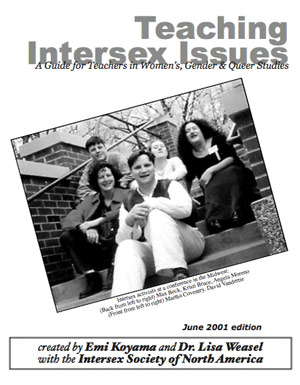Teaching intersex issues
The listed resources are no longer current in this document published by ISNA in 2001, but we highly recommend Teaching intersex issues by Emi Koyama and Dr Lisa Weasel. It contains analysis, guidelines, readings and other resources.
The authors present an analysis of self-selected scholars teaching women’s studies, queer studies and related fields in early 2001. It found that the subject of intersex was approached as a means of deconstructing binary sexes and compulsory heterosexuality, “rather than a subject that has real-world implications for real people”.

[There is] a common problem within women’s, gender and queer studies: discussions about intersex existence are “stuck” at where it is used to deconstruct sexes, gender roles, compulsory heterosexuality, and even Western science, rather than addressing medical ethics or other issues that directly impact lives of intersex people… the truth is not that these discussions are “stuck” prematurely, but they are starting from a wrong place with a wrong set of priorities.
Avoidance of discussion of intersex physical, medical and health issues can serve to reduce intersex to biological trivia, “embarrassing bodies”, or a perceived identity issue, rather than intersex as “a site of intimate physical violation”, an issue of human rights and social justice. Focusing on more comfortable gender issues invisibilises intersex people, and privileges the needs of non-intersex people over the needs of people born intersex.
Intersex people, and intersex-led organisations, need to be centred in discussions about intersex. As the disability movement states, we want “nothing about us without us”.
The document presents eight guidelines aimed at changing the way that intersex issues are addressed in education, and a sample course unit.
You must be logged in to post a comment.